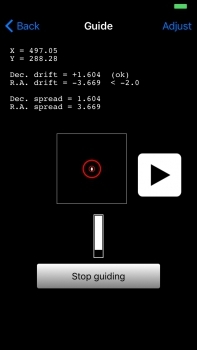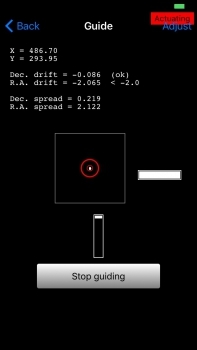Guiding
Once the app is calibration, you can guiding using the chosen guide start. Start guiding by pushing „Guiding” in main menu and „Start guiding” subsequently. Pushing „Stop guiding” ends the guiding
How guiding works, depends on the guiding mode you have chosen.
Mode: Manual guiding
In manual guiding mode, the app has now control on your telescope. Instead, it analyses deviations from the guide star and gives you advice, how to bring the guide star back to position. Just click the keys on the hand controller that the app shows in the display. This mode requires some practice but enables guiding without buying a special adapter.
Mode: Automatic guiding
In automatic guiding mode, the app takes care of guiding. The app connects with your telescope and transmits actuation commands as soon as the guide star deviates from its original position. The connection to the telescope is configured in the app settings.
Guiding the right way
When starting the guiding, the app waits for short period as the telescope might swing after touching the screen. Ensure not to touch the telescope or the display during guiding. A long exposure photo can now be taken between the start and the end of guiding.
Note the statistics that are shown during guiding. The declination and right ascension spread is important. Both values denote how large the guiding error is, measured in pixels of the smartphone camera. This value should be as small as possible.
The app also shows the guiding error as bars in relation to a configured error threshold. When the error raises, the bar is filled. When the bar is full, the aligment of the telescope should be corrected.
The quality of guiding strongly depends on the the settings that you find when pushing „Adjust”.

